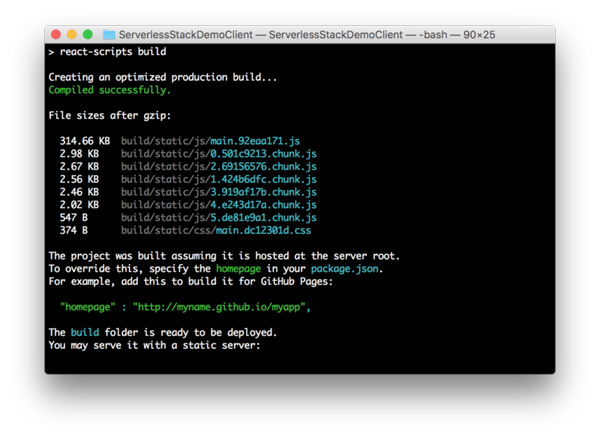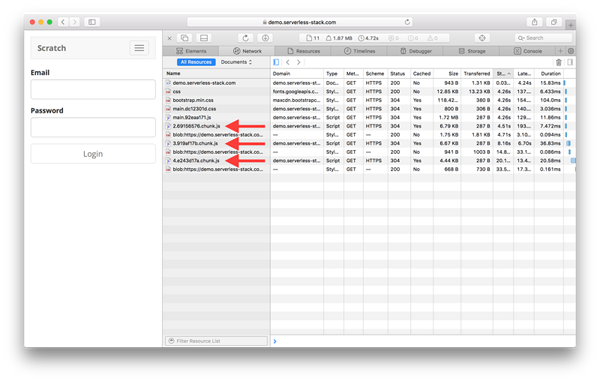您好,登錄后才能下訂單哦!
您好,登錄后才能下訂單哦!
這篇文章主要講解了“Create React App路由4.0的異步組件加載有什么作用”,文中的講解內容簡單清晰,易于學習與理解,下面請大家跟著小編的思路慢慢深入,一起來研究和學習“Create React App路由4.0的異步組件加載有什么作用”吧!
基于 Create React App路由4.0的異步組件加載
本文章是一個額外的篇章,它可以在你的React app中,幫助加快初始的加載組件時間。當然這個操作不是完全必要的,但如果你好奇的話,請隨意跟隨這篇文章一起用Create React App和 react路由4.0的異步加載方式來幫助react.js構建大型應用。
代碼分割(Code Splitting)
當我們用react.js寫我們的單頁應用程序時候,這個應用會變得越來越大,一個應用(或者路由頁面)可能會引入大量的組件,可是有些組件是***次加載的時候是不必要的,這些不必要的組件會浪費很多的加載時間。
你可能會注意到 Create React App 在打包完畢之后會生成一個很大的.js文件,這包含了我們應用程序需要的所有JavaScript。但是,如果用戶只是加載登錄頁面去登錄網站,我們加載應用程序的其余部分是沒有意義的。在我們的應用程序還很小的時候,這并不是一個問題,但是它卻是我們程序猿優化的一個東西。為了解決這個問題,Create React App有一個非常簡單的代碼分割的的方案。
代碼分割和 react-router
在我們 react app 中,常見的路由配置可能是像下面一樣的
/* Import the components */ import Home from './containers/Home'; import Posts from './containers/Posts'; import NotFound from './containers/NotFound'; /* Use components to define routes */ export default () => ( <Switch> <Route path="/" exact component={Home} /> <Route path="/posts/:id" exact component={Posts} /> <Route component={NotFound} /> </Switch> );我們一開始引入這些組件,然后定義好的路徑,會根據我們的路由去匹配這些組件。
但是,我們靜態地在頂部導入路由中的所有組件。這意味著,不管哪個路由匹配,所有這些組件都被加載。我們只想加載對匹配路由的時候才加載響應的組件。下面我們一步步來完成這個使命。
創建一個異步組件
創建一個js 文件,如:src/components/AsyncComponent.js,代碼如下
import React, { Component } from 'react'; export default function asyncComponent(importComponent) { class AsyncComponent extends Component { constructor(props) { super(props); this.state = { component: null, }; } async componentDidMount() { const { default: component } = await importComponent(); this.setState({ component: component }); } render() { const C = this.state.component; return C ? <C {...this.props} /> : null; } } return AsyncComponent; }我們在這里做了一些事情:
鴻蒙官方戰略合作共建——HarmonyOS技術社區
這個asyncComponent 函數接受一個importComponent 的參數,importComponent 調用時候將動態引入給定的組件。
在componentDidMount 我們只是簡單地調用importComponent 函數,并將動態加載的組件保存在狀態中。
***,如果完成渲染,我們有條件地提供組件。在這里我們如果不寫null的話,也可提供一個菊花圖,代表著組件正在渲染。
使用異步組件
現在讓我們使用我們的異步組件,而不是像開始的靜態去引入。
import Home from './containers/Home';
我們要用asyncComponent組件來動態引入我們需要的組件。
tip: 別忘記 先 import asyncComponent from './AsyncComponent
const AsyncHome = asyncComponent(() => import('./containers/Home'));我們將要使用 AsyncHome 這個組件在我們的路由里面
<Route path="/" exact component={AsyncHome} />現在讓我們回到Notes項目并應用這些更改。
src/Routes.js
import React from 'react'; import { Route, Switch } from 'react-router-dom'; import asyncComponent from './components/AsyncComponent'; import AppliedRoute from './components/AppliedRoute'; import AuthenticatedRoute from './components/AuthenticatedRoute'; import UnauthenticatedRoute from './components/UnauthenticatedRoute'; const AsyncHome = asyncComponent(() => import('./containers/Home')); const AsyncLogin = asyncComponent(() => import('./containers/Login')); const AsyncNotes = asyncComponent(() => import('./containers/Notes')); const AsyncSignup = asyncComponent(() => import('./containers/Signup')); const AsyncNewNote = asyncComponent(() => import('./containers/NewNote')); const AsyncNotFound = asyncComponent(() => import('./containers/NotFound')); export default ({ childProps }) => ( <Switch> <AppliedRoute path="/" exact component={AsyncHome} props={childProps} /> <UnauthenticatedRoute path="/login" exact component={AsyncLogin} props={childProps} /> <UnauthenticatedRoute path="/signup" exact component={AsyncSignup} props={childProps} /> <AuthenticatedRoute path="/notes/new" exact component={AsyncNewNote} props={childProps} /> <AuthenticatedRoute path="/notes/:id" exact component={AsyncNotes} props={childProps} /> { /* Finally, catch all unmatched routes */ } <Route component={AsyncNotFound} /> </Switch> );只需幾次更改就相當酷了。我們的app都是設置了代碼分割而的。也沒有增加太多的復雜性。
這里我們看看之前的這個src/Routes.js路由文件
import React from 'react'; import { Route, Switch } from 'react-router-dom'; import AppliedRoute from './components/AppliedRoute'; import AuthenticatedRoute from './components/AuthenticatedRoute'; import UnauthenticatedRoute from './components/UnauthenticatedRoute'; import Home from './containers/Home'; import Login from './containers/Login'; import Notes from './containers/Notes'; import Signup from './containers/Signup'; import NewNote from './containers/NewNote'; import NotFound from './containers/NotFound'; export default ({ childProps }) => ( <Switch> <AppliedRoute path="/" exact component={Home} props={childProps} /> <UnauthenticatedRoute path="/login" exact component={Login} props={childProps} /> <UnauthenticatedRoute path="/signup" exact component={Signup} props={childProps} /> <AuthenticatedRoute path="/notes/new" exact component={NewNote} props={childProps} /> <AuthenticatedRoute path="/notes/:id" exact component={Notes} props={childProps} /> { /* Finally, catch all unmatched routes */ } <Route component={NotFound} /> </Switch> );注意,不要在頂部的引入所有的組件。我們正在創建這些代碼分割的功能,以便在必要時為我們進行動態導入。
現在你運行npm run build 您將看到代碼已經被分割成一個個小文件。

下面是部署好的在網站的真實截圖

每個.chunk.js都是需要的時候才加載的。當然我們的程序是相當小的,并且分離在各個部分的小組件,是不需要這樣子按需加載的。還是看你項目的需求。
感謝各位的閱讀,以上就是“Create React App路由4.0的異步組件加載有什么作用”的內容了,經過本文的學習后,相信大家對Create React App路由4.0的異步組件加載有什么作用這一問題有了更深刻的體會,具體使用情況還需要大家實踐驗證。這里是億速云,小編將為大家推送更多相關知識點的文章,歡迎關注!
免責聲明:本站發布的內容(圖片、視頻和文字)以原創、轉載和分享為主,文章觀點不代表本網站立場,如果涉及侵權請聯系站長郵箱:is@yisu.com進行舉報,并提供相關證據,一經查實,將立刻刪除涉嫌侵權內容。